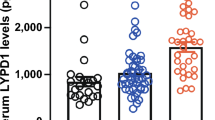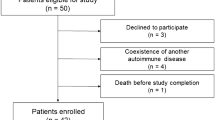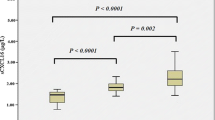Abstract
Systemic sclerosis (SSc) is a systemic disorder that typically results in fibrosis of the skin and multiple internal organ systems. Although the precise mechanism is unknown, overproduction of extracellular matrix proteins, including collagens and fibronectins, and aberrant immune activation might be involved in the pathogenesis. The soluble cluster of differentiation 21 (sCD21) represents the extracellular portion of the CD21 glycoprotein that is released by shedding from the cell surfaces into plasma. sCD21 binds complement fragments and activates monocytes through binding to membrane CD23. The present study was undertaken to investigate the serum levels of sCD21 in patients with SSc. Serum sCD21 levels were reduced with age both in patients with SSc and normal controls. Serum sCD21 levels in patients with SSc were significantly decreased compared to those in control subjects. When we divided patients with SSc into limited cutaneous SSc (lcSSc) and diffuse cutaneous SSc (dcSSc), patients with lcSSc had lower levels of serum sCD21 than those with dcSSc. Moreover, the prevalence of pulmonary fibrosis in the patients with dcSSc inversely correlated with serum sCD21 levels. Our finding may support the notion that B-cell activation is involved in the mechanism for pulmonary fibrosis and skin sclerosis.


Similar content being viewed by others
References
Mauch C, Eckes B, Hunzelmann N, Oono T, Kozlowska E, Krieg T (1993) Control of fibrosis in systemic scleroderma. J Invest Dermatol 100:92S–96S
Le Roy EC (1992) A brief overview of the pathogenesis of scleroderma (systemic sclerosis). Ann Rheum Dis 51:286–288
Cherukuri A, Cheng PC, Sohn HW, Pierce SK (2001) The CD19/CD21 complex functions to prolong B cell antigen receptor signaling from lipid rafts. Immunity 14:169–179
Nielsen CH, Leslie RG (2002) Complement’s participation in acquired immunity. J Leuko Biol 72:249–261
Nielsen CH, Pedersen ML, Marquart HV, Prodinger WM, Leslie RG (2002) The role of complement receptors type 1 (CR1, CD35) and 2 (CR2, CD21) in promoting C3 fragment deposition and membrane attack complex formation on normal peripheral human B cells. Eur J Immunol 32:1359–1367
Dempsey PW, Fearon DT (1996) Complement: instructing the acquired immune system through the CD21/CD19 complex. Res Immunol 147(71–75):119–120
Cherukuri A, Cheng PC, Pierce SK (2001) The Role of CD19/CD21 complex in B cell processing and presentation of complement-tagged antigens. J Immunol 167:163–172
Myones BL, Ross GD (1987) Identification of a spontaneously shed fragment of B cell complement receptor type two (CR2) containing the C3d-binding site. Complement 4:87–98
Ling N, Hansel T, Richardson P, Brown B (1991) Cellular origins of serum complement receptor type 2 in normal individuals and in hypogammaglobulinemia. Clin Exp Immunol 84:16–22
Huemer HP, Larcher C, Prodinger WM, Petzer AL, Mitterer M, Falser N (1993) Determination of soluble CD21 as a parameter of B cell activation. Clin Exp Immunol 93:195–199
Fremeaux-Bacchi V, Kolb JP, Rakotobe S, Kazatchkine MD, Fischer EM (1999) Functional properties of soluble CD21. Immunopharmacol 42:31–37
Fischer E, Delibrias C, Kazatchkine MD (1991) Expression of CR2 (the C3dg/EBV receptor, CD21) on normal human peripheral blood T lymphocytes. J Immunol 146:865–869
Fingeroth JD, Weis JJ, Tedder TF, Strominger JL, Biro PA, Fearon DT (1984) Epstein-Barr virus receptor of human B lymphocytes is the C3d receptor CR2. Proc Natl Acid Sci USA 81:4510–4514
Lowe J, Brown B, Hardie D, Richardson P, Ling N (1989) Soluble forms of CD21 and CD23 antigens in the serum in B cell chronic lymphocytic leukemia. Immunol Lett 20:103–109
Masilamani M, Nowack R, Witte T, Schlesir M, Warnatz K, Glocker MO, Peter HH, Illges H (2004) Reduction of soluble complement receptor 2/CD21 in systemic lupus erythomatosus and Sjogren’s syndrome but not juvenile arthritis. Scand J Immunol 60:625–630
Subcommittee for Scleroderma Criteria of the American Rheumatism Association Diagnotic, Therapeutic Criteria Committee (1980) Preliminary criteria for the classification of systemic sclerosis (scleroderma. Arthritis Rheum 23:581–590
Steen VD, Medsger TA Jr (2000) Severe organ involvement in systemic sclerosis with diffuse scleroderma. Arthritis Rheum 43:2437–2444
Masilamani M, von Kempis J, Illges H (2004) Decreased levels of serum soluble complement receptor-II (CR2/CD21) in patients with rheumatoid arthritis. Rheumatol (Oxford) 43:186–190
Fischer EM, Mouhoub A, Maillet F et al (1999) Expression of CD21 is developmentally regulated during thymic maturation of human T lymphocytes. Int Immunol 11:1841–1849
Okano Y (1996) Antinuclear antibody in systemic sclerosis (scleroderma). Rheum Dis Clin North Am 22:709–735
Famularo G, Giacomelli R, Alesse E, Cifone MG, Morrone S, Boirivant M, Danese C, Perego MA, Santoni A, Tonietti G (1989) Polyclonal B lymphocyte activation in progressive systemic sclerosis. J Clin Lab Immunol 29:59–63
Whitefield ML, Finlay DR, Murray JI, Troyanskaya OG, Chi JT, Pergamenschikov A, McCalmont TH, Brown PO, Botstein D, Connolly MK (2003) Systemic and cell type-specific gene expression patterns in scleroderma skin. Proc Natl Acad Sci USA 100:12319–12324
Sato S, Hasegawa M, Fujimoto M, Tedder TF, Takehara K (2000) Quantitative genetic variation in CD19 expression correlates with autoimmunity in mice and humans. J Immunol 165:6635–6643
Sato S, Fujimoto M, Hasegawa M, Takehara K (2004) Altered blood B lymphocyte homeostasis in systemic sclerosis. Expanded naïve B cells and diminished but activated memory B cells. Arthritis Rheum 50:1918–1927
Singh A, Blank M, Shoenfeld Y, Illges H (2008) Antiphospholipid syndrome patients display reduced titers of soluble CD21 in their sera irrespective of circulating anti-β2-glycoprotein-I autoantibodies. Rheumatol Int 28:661–665
Masilamani M, Rajasekaran N, Singh A, Low H, Albus K, Anders S, Behne F, Eiermann P, Konig K, Mindnich C, Ribarska T, Illges H (2008) Systemic reduction of soluble complement receptor II/CD21 during pregnancy to levels reminiscent of autoimmune disease. Rheumatol Int 28:1137–1141
Kuroda K, Shinkai H (1997) Gene expression of types I and III collagen, decorin, matrix metalloproteinases and tissue inhibitors of metalloproteinases in skin fibroblasts from patients with systemic sclerosis. Arch Dermatol Res 289:567–572
Mattila L, Airola K, Ahonen M, Hietarinta M, Black C, Saarialho-Kere U, Kahari VM (1998) Activation of tissue inhibitor of metalloproteinase-3 (TIMP-3) mRNA expression in scleroderma skin fibroblasts. J Invest Dermatol 110:416–421
Strehlow D, Jelaska A, Strehlow K, Korn JH (1999) A potential role for protease nexin 1 overexpression in the pathogenesis of scleroderma. J Clin Invest 103:1179–1190
Feghali CA, Wright TM (1999) Identification of multiple, differentially expressed messenger RNAs in dermal fibroblasts from patients with systemic sclerosis. Arthritis Rheum 42:1451–1457
Oliveira JG, Guedes ACM, Lanna CCDL, Coelho LFL, Prados RZ, Feghali C, Ferreira PCP, Erna Kroon G (2002) Protease nexin-1 messenger RNA levels are not affected by serum or interferon beta in cultured systemic sclerosis fibroblasts. Arch Dermatol Res 293:584–589
Dowd PM, Kiirby JD, Holborow EJ, Cooke ED, Bowcock SA (1981) Detection of immune complexes in systemic sclerosis and Raynaud’s phenomenon. Br J Dermatol 105:179–188
Seibold JR, Medsger TA Jr, Alan Winkelstein A, Kelly RH, Rodnan GP (2005) Immune complexes in progressive systemic sclerosis (scleroderma). Arthritis Rheum 25:1167–1173
French MAH, Harrison G, Penning CA, Cunningham J, Hughes P, Rowell NR (1985) Serum immune complexes in systemic sclerosis: relationship with precipitating nuclear antibodies. Ann Rheum Dis 44:89–92
Xiang Y, Matsui T, Matsuo K, Shimada K, Tohma S, Nakamura H, Masuko K, Yudoh K, Nishioka K, Kato T (2007) Comprehensive investigation of disease-specific short peptides in sera from patients with systemic sclerosis. Arthritis Rheum 56:2018–2030
McCoy RC, Tisher CC, Pepe PF, Cleveland LA (1976) The kidney in progressive systemic sclerosis: immunohistochemical and antibody elution studies. Lab Invest 35:124–132
Seibold JR, Medsger TA Jr, Winkelstein A, Kelly RH, Rodnan GP (1982) Immune complexes in progressive systemic sclerosis (scleroderma). Arthritis Rheum 25:1167–1174
von Bierbrauer AFG, Mennel HD, Schmidt JA, von Wichert P (1996) Intravital microscopy and capillaroscopically guided nail fold biopsy in scleroderma. Ann Rheum Dis 55:305–310
Senaldi G, Lupoli S, Vergani D, Black CM (1989) Activation of the complement system in systemic sclerosis. Relationship to clinical severity. Arthritis Rheum 32:1262–1267
Author information
Authors and Affiliations
Corresponding author
Rights and permissions
About this article
Cite this article
Tomita, M., Kadono, T., Yazawa, N. et al. Serum levels of soluble CD21 in patients with systemic sclerosis. Rheumatol Int 32, 317–321 (2012). https://doi.org/10.1007/s00296-010-1610-3
Received:
Accepted:
Published:
Issue Date:
DOI: https://doi.org/10.1007/s00296-010-1610-3




